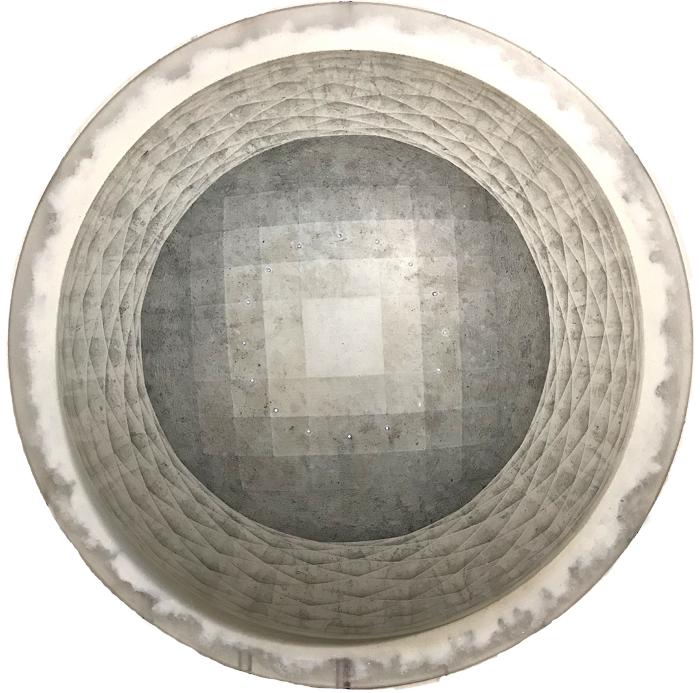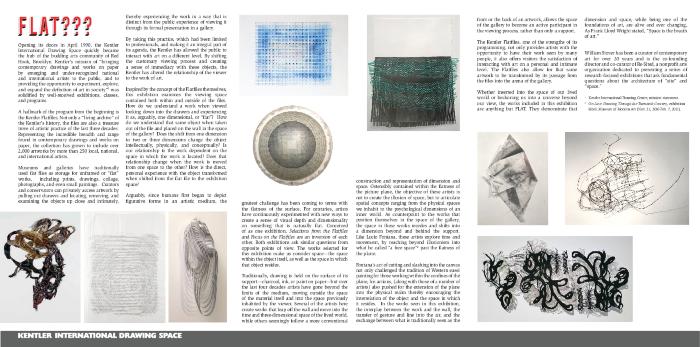exhibition
Flat??? Selections from the Kentler Flatfiles
Guest Curator: William Stover
Date
June 8 – July 15, 2018Opening Reception
June 8, 2018Artists
Golnar Adili, Hedwig Brouckaert, Hannah Israel, Gahae Park, Jaanika Peerna, Gelah Penn, Carol Prusa, Mary Ting, Hugh WilliamsRelated exhibition
Focus on the Flatfiles: Flat???Related event
Curator's Talk: William Stoverexhibition Images
Click to Enlarge.

Golnar Adili, She Feels Your Absence Deeply, 2015, Silkscreen on 5 sheets of tissue paper, 36 in X 25 in.

Hedwig Brouckaert, A knot, a tangle, a blemish in the eternal smoothness (1d), 2014, Collage, 12 in X 9 in.

Hedwig Brouckaert, A knot, a tangle, a blemish in the eternal smoothness (1e), 2014, Collage, 12 in X 9 in.

Mary Ting, Centipede Gardener, 2009 – 2017, Silkscreen, cutouts, stamps on Tyvek, 17 in X 34 in.
No longer available
Press and Promotion
About the exhibition
Flat??? Selections from the Kentler Flatfiles
Guest Curator: William Stover
June 8 – July 15, 2018
FLAT???
Opening its doors in April 1990, the Kentler International Drawing Space quickly became the hub of the budding arts community of Red Hook, Brooklyn. Kentler’s mission of “bringing contemporary drawings and works on paper by emerging and under-recognized national and international artists to the public, and to providing the opportunity to experiment, explore, and expand the definition of art in society”1 was solidified by well-received exhibitions, classes, and programs.
A hallmark of the program from the beginning is the Kentler Flatfiles. Not only a “living archive” of the Kentler’s history, the files are also a treasure trove of artistic practice of the last three decades. Representing the incredible breadth and range found in contemporary drawings and works on paper, the collection has grown to include over 2,000 artworks by more than 250 local, national, and international artists.
Museums and galleries have traditionally used flat files as storage for unframed or “flat” works, including prints, drawings, collage, photographs, and even small paintings. Curators and conservators can privately access artwork by pulling out drawers, locating, removing and examining the objects up -close and intimately, . Thereby experiencing the work in a way that was distinct from the public experience of viewing it through its formal presentation in a gallery.
By taking this practice, which had been limited to professionals, and making it an integral part of its agenda, the Kentler has allowed the public to interact with art on a different level. By shifting the customary viewing process and creating a sense of immediacy with these objects, the Kentler has altered the relationship of the viewer to the work of art.
Inspired by the concept of the Flatfiles themselves, this exhibition examines the viewing space contained both within and outside of the files. How do we understand a work when viewed looking down into the drawers and experiencing it as, arguably, one dimensional, or “flat"? How do we understand that same object when taken out of the file and placed on the wall in the space of the gallery? Does the shift from one dimension to two or three dimensions change the object intellectually, physically, and conceptually? Is our relationship to the work dependent on the space in which the work is located? Does that relationship change when the work is moved from one space to the other? How is the direct, personal experience with the object transformed when shifted from the flat file to the exhibition space?
Arguably, since humans first began to depict figurative forms in an artistic medium, the greatest challenge has been coming to terms with the flatness of the surface. For centuries, artists have continuously experimented with new ways to create a sense of visual depth and dimensionality on something that is naturally flat. Conceived of as one exhibition, Selections from the Kentler Flatfiles and Focus on the Flatfiles are an inversion of each other. Both ask similar questions from opposite points of view. The works selected for this exhibition make us consider space—the space within the object itself, as well as the space in which that object resides.
Traditionally, drawing is held on the surface of its support—charcoal, ink, or paint on paper— but over the last four decades artists have gone beyond the limits of the medium, moving outside the space of the material itself and into the space previously inhabited by the viewer. Several of the artists here create works that leap off the wall and move into the time and three-dimensional space of the lived world, while others seemingly follow a more conventional construction and representation of dimension and space. Ostensibly contained within the flatness of the picture plane, the objective of these artists it not to create the illusion of space, but to articulate spatial concepts ranging from the physical spaces we inhabit to the psychological dimensions of an inner world. As counterpoint to the works that position themselves in the space of the gallery, the space in these works recedes and shifts into a dimension beyond and behind the support. Like Lucio Fontana, these artists explore time and movement, by reaching beyond illusionism into what he called “a free space”2 past the flatness of the plane.
Fontana’s act of cutting and slashing into the canvas, not only challenged the tradition of Western easel painting for those working within the confines of the plane, his actions, (along with those of a number of artists) also pushed for the extension of the plane into the physical realm thereby encouraging the interrelation of the object and the space in which it resides. In the works seen in this exhibition, the interplay between the work and the wall, the transfer of gesture and line into the air and the exchange between what is traditionally seen as the front or the back of an artwork, allows the space of the gallery to become an active participant in the viewing process, rather than only a support.
The Kentler Flatfiles, one of the strengths of its programming, not only provides artists with the opportunity to have their work seen by many people, it also offers visitors the satisfaction of interacting with art on a personal and intimate level. The Flatfiles also allows for that same artwork to be transformed by its passage from the files into the arena of the gallery.
Whether inserted into the space of our lived world or beckoning us into a universe beyond our view, the works included in this exhibition are anything but FLAT. They demonstrate that dimension and space, while being one of the foundations of art, are alive and ever changing. As Frank Lloyd Wright stated, "Space is the breath of art.”
- Kentler International Drawing Center, mission statement.
- On Line: Drawing Through the Twentieth Century, exhibition label, Museum of Modern Art (Nov. 21, 2010-Feb. 7, 2011).
William Stover has been a curator of contemporary art for over 20 years and is the co-founding director and co-curator of Re-Sited, a nonprofit arts organization dedicated to presenting a series of research-focused exhibitions that ask fundamental questions about the architecture of “site” and “space.”
Video Link to Curator's Talk


















